
Sorrel, also called common sorrel or garden sorrel, is a perennial herbaceous plant in the family Polygonaceae. Other names for sorrel include spinach dock and narrow-leaved dock.

Rumex crispus, the curly dock, curled dock or yellow dock, is a perennial flowering plant in the family Polygonaceae, native to Europe and Western Asia.

Melanthieae is a tribe of flowering plants within the family Melanthiaceae. Molecular phylogenetic studies in the 21st century have resulted in a large-scale reassignment of many of its species to different genera; in particular the genus Zigadenus (deathcamases) has been restricted to a single species, Zigadenus glaberrimus. Plants contain alkaloids, making them unpalatable to grazing animals; many are very poisonous to both animals and humans.

Ficus benjamina, commonly known as weeping fig, benjamin fig or ficus tree, and often sold in stores as just ficus, is a species of flowering plant in the family Moraceae, native to Asia and Australia. It is the official tree of Bangkok. The species is also naturalized in the West Indies and in the states of Florida and Arizona in the United States. In its native range, its small fruit are favored by some birds.
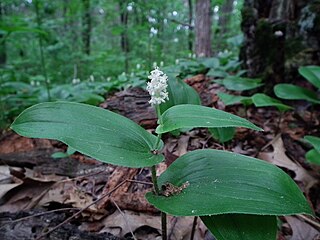
Maianthemum canadense is an understory perennial flowering plant, native to Canada and the northeastern United States, from Yukon and British Columbia east to Newfoundland, into St. Pierre and Miquelon. It can be found growing in both coniferous and deciduous forests. The plant appears in two forms, either as a single leaf rising from the ground with no fruiting structures or as a flowering/fruiting stem with 2-3 leaves. Flowering shoots have clusters of 12–25 starry-shaped, white flowers held above the leaves.

Rumex maritimus, commonly called golden dock, bristle dock, or seashore dock, is an annual plant species of the genus Rumex. Rumex maritimus grows in Argentina, Burma, Canada, China, and the United States. It is native to Canada and most of the 48 states. The life span of Rumex maritimus is rarely biennial in moist environments. This herb belongs to the family Polygonaceae.
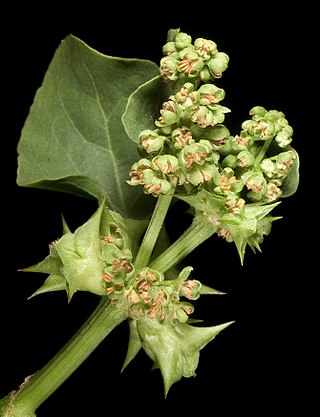
Rumex hypogaeus, commonly known in English as southern threecornerjack, devil's thorn, or double gee, is a herbaceous plant of the Polygonaceae. It is native in South Africa and is an invasive species in Australia, Texas in the USA & Pakistan.

Erythronium revolutum is a species of flowering plant in the family Liliaceae which is known by several common names, including mahogany fawn lily, coast fawn lily, and pink fawn lily. It is native to the west coast of North America.
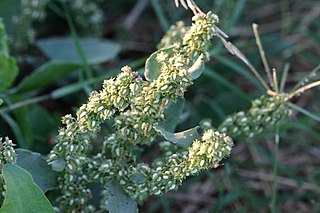
Rumex stenophyllus is a species of flowering plant in the knotweed family known by the common name narrow-leaf dock. It is native to Eurasia and it can be found in parts of North America as an introduced species and roadside weed. It grows in moist and wet habitat, often in areas with saline soils. It is a perennial herb producing an erect stem from a thick taproot, usually measuring 40 to 80 centimeters tall, but known to well exceed one meter. The leaves are up to 30 centimeters long and are generally lance-shaped with curled edges. The inflorescence is an interrupted series of clusters of flowers with 20 to 25 in each cluster, each flower hanging from a pedicel. The flower has usually six tepals, the inner three of which are largest, triangular and edged with teeth, and bearing tubercles.
Crepis pleurocarpa is a North American species of flowering plant in the family Asteraceae known by the common name nakedstem hawksbeard. It is native to the western United States (Washington, Oregon, northern California and western Nevada.
Sagittaria longiloba is a species of flowering plant in the water plantain family known by the common name longbarb arrowhead and Gregg arrowhead. It is native to the south-central and southwestern United States plus Mexico, Venezuela and Nicaragua. It is also reportedly naturalized in the western Himalayas of India and Bhutan. It grows in slow-moving, stagnant, and ephemeral water bodies such as ponds and small streams, and sometimes disturbed and cultivated habitat such as rice fields and irrigation ditches.
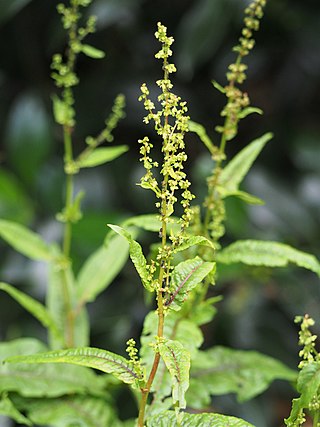
Rumex sanguineus, commonly known as wood dock, bloody dock or red-veined dock, is a perennial flowering plant species in the family Polygonaceae. Rumex sanguineus is a dicot and can be observed in Europe with at least two varieties.

Rumex britannica is a flowering plant species in the family Polygonaceae.(Buckwheat family) (perennial).

Rumex hastatulus, commonly known as the heartwing sorrel, is an annual flowering plant species in the family Polygonaceae otherwise known as the buckwheat family. It is found spread out through the eastern and southern United States.
Rumex utahensis is a flowering plant species in the family Polygonaceae. The common name for this species is Utah dock. It is a dicot, perennial herb that is native to the United states, growing only in the West.
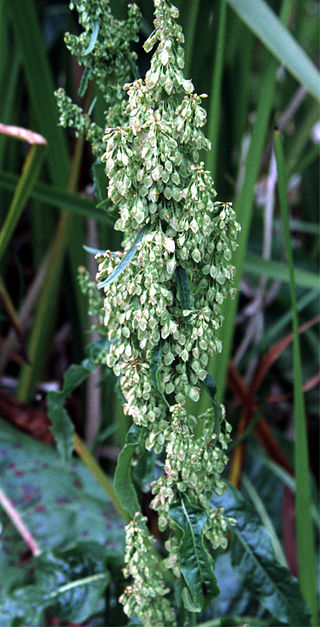
Rumex occidentalis is a flowering plant species belonging to the family Polygonaceae. Commonly known as western dock, Rumex occidentalis can be found in parts of Western North America.
Rumex lapponicus, known commonly as Lapland mountain sorrel is a perennial flowering herb species in the family Polygonaceae. It is commonly found in meadows and rock outcrops, as well as montane, arenicolous, and alluvial habitats.
Rumex floridanus is a perennial flowering plant, in the family Polygonaceae. The common name for this species is Florida dock.

Rumex cuneifolius is a flowering plant species in the family Polygonaceae.

Rumex rupestris, commonly known as shore dock, is a species of flowering plant belonging to the family Polygonaceae. Its native range is Western Europe and is one of the world's rarest dock species.


















